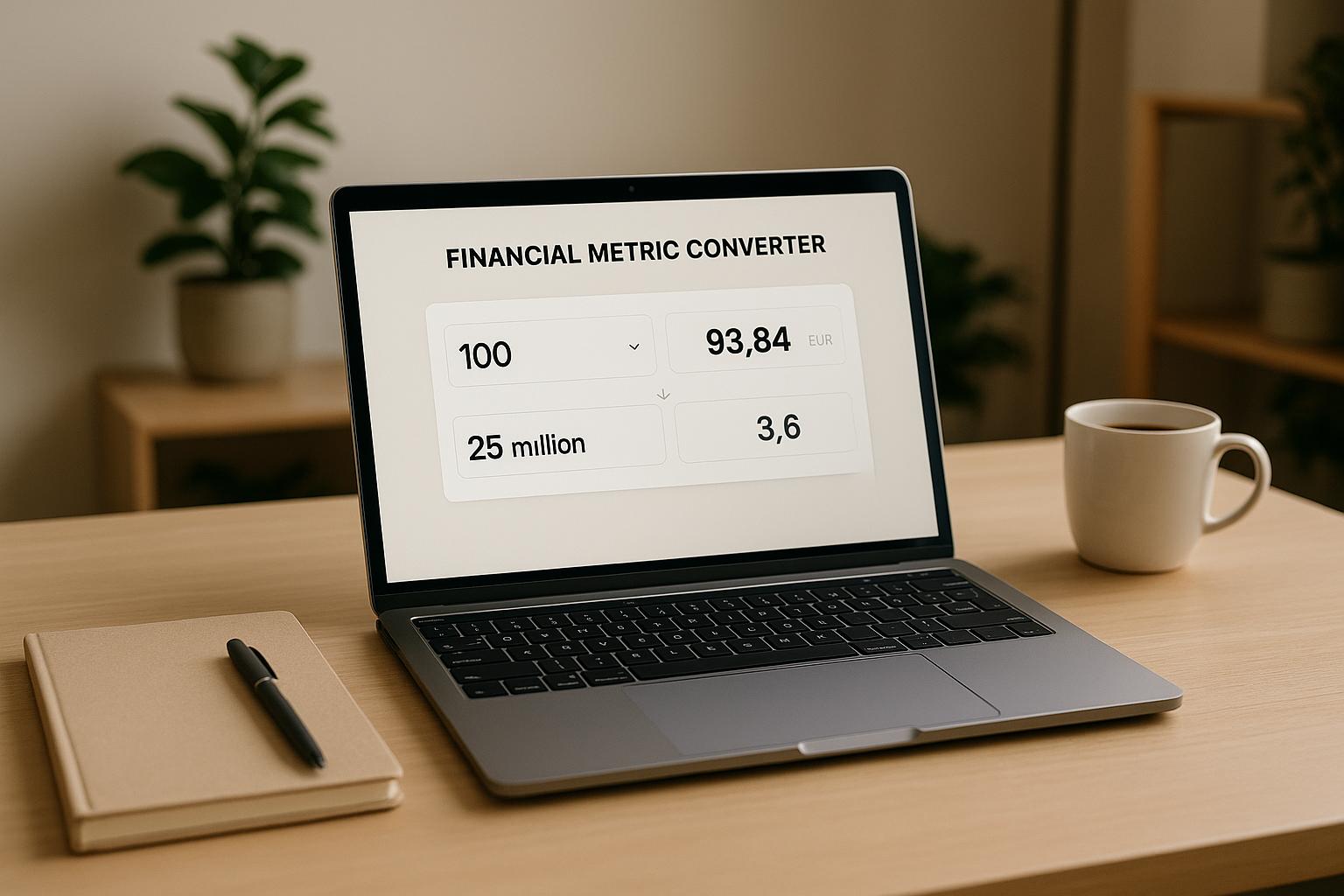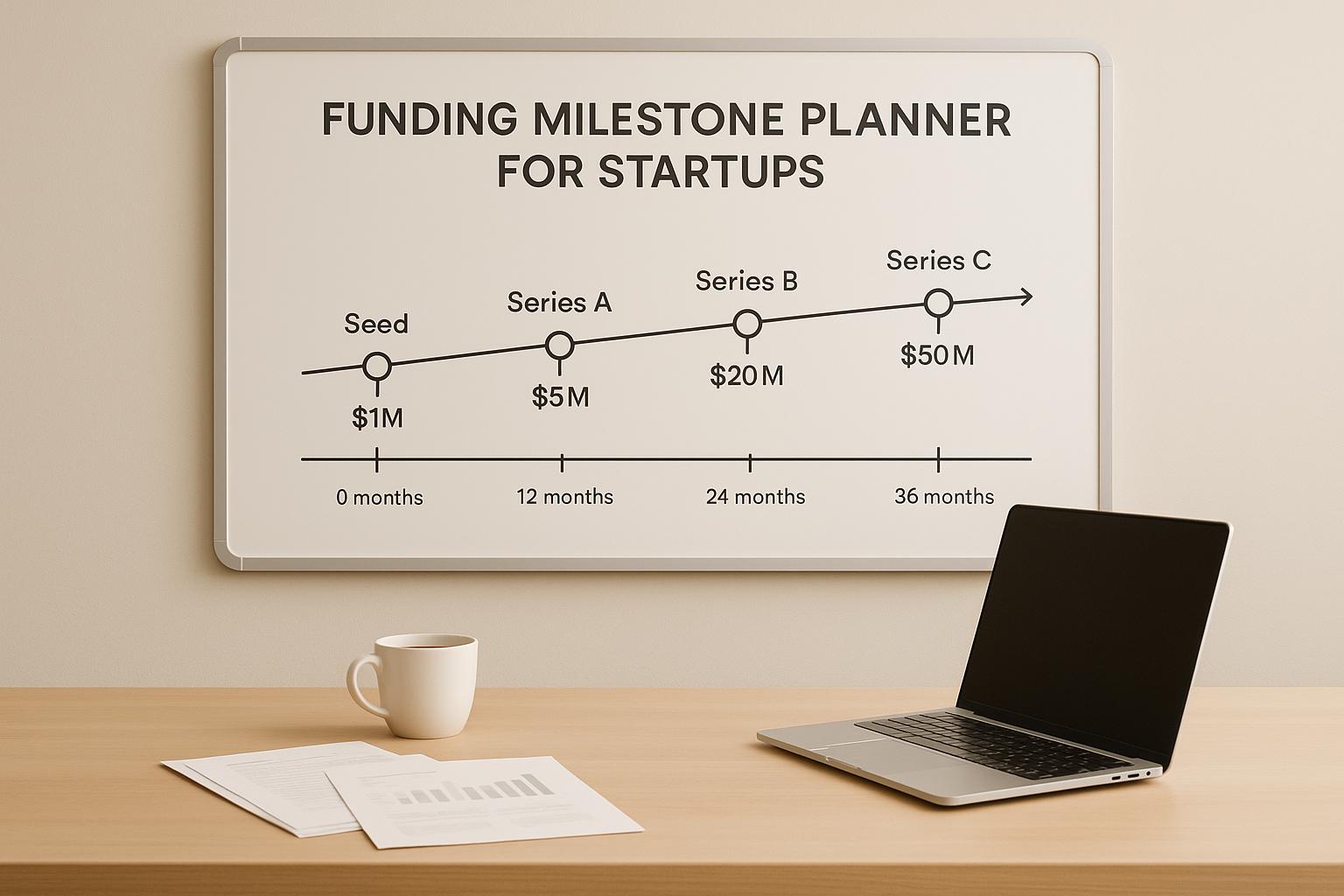How Burn Rate Scenarios Impact Cash Flow

Burn rate measures how quickly your business spends money each month, directly affecting how long you can operate before running out of cash. Mismanagement of burn rate is a major reason why 82% of businesses fail due to cash flow issues. Here's why it matters and how to manage it effectively:
-
Key Metrics:
- Gross burn rate: Total monthly expenses (e.g., payroll, rent).
- Net burn rate: Gross burn rate minus monthly revenue.
- Cash runway: Current cash balance divided by monthly burn rate.
-
Why It’s Important:
- A high burn rate can drain reserves, delay payments, and force tough decisions like layoffs.
- Investors prioritize companies with well-managed burn rates and a clear path to profitability.
- Maintaining 12–18 months of cash runway is ideal for financial stability.
-
Common Scenarios:
- High Spending, Low Revenue: Overspending on growth without enough income can lead to funding challenges.
- Capital-Intensive Investments: Large upfront costs in industries like manufacturing can strain cash flow until revenue catches up.
- Seasonal Revenue Gaps: Businesses with fluctuating income must plan for slower periods to avoid cash shortages.
-
Solutions:
- Cut non-essential expenses, renegotiate contracts, and delay new hires.
- Increase revenue by offering upfront payment discounts, expanding product lines, or focusing on high-margin offerings.
- Use financial tools to model best- and worst-case scenarios, ensuring better decision-making.
Managing burn rate is essential for balancing growth and financial health. By tracking expenses, planning for different scenarios, and making data-driven decisions, businesses can extend their runway and stay on track toward their goals.
What is Burn Rate and how to calculate it? - StartUp Terms
How Burn Rate Impacts Cash Flow
Grasping how burn rate influences cash flow is crucial for keeping your business afloat. Tracking these numbers gives you the data you need to make smart decisions about spending, hiring, and fundraising. These metrics don’t just reflect your current performance - they also help shape your long-term strategy, a topic we’ll dive deeper into with scenario analysis later on.
What Are Burn Rate and Cash Runway

Let’s break it down. Burn rate tells you how quickly your business is spending cash each month. There are two key types to know: gross burn rate and net burn rate.
- Gross burn rate represents all your monthly expenses - things like payroll, rent, marketing, and software costs. For example, if your startup spends $150,000 a month on operating expenses, that’s your gross burn rate [6].
- Net burn rate gives a clearer picture by subtracting your monthly revenue from those expenses. Using the same example, if you bring in $50,000 in monthly revenue, your net burn rate would be $100,000 ($150,000 - $50,000) [6].
Then there’s cash runway, which tells you how long your business can keep running before the money runs out. To calculate it, divide your current cash balance by your monthly burn rate.
Here’s a simple example for a U.S.-based SaaS startup:
| Metric | Calculation | Example |
|---|---|---|
| Gross Burn Rate | Total monthly expenses | $50,000/month |
| Net Burn Rate | Gross burn rate - monthly revenue | $50,000 - $20,000 = $30,000/month |
| Cash Runway | Cash balance ÷ monthly burn rate | $90,000 ÷ $30,000 = 3 months |
For context, SaaS startups with less than $1 million in annual recurring revenue often have burn rates between $50,000 and $175,000 per month [2].
Understanding these figures is the first step to seeing why burn rate is such a critical factor for businesses in their growth phase.
Why Burn Rate Matters for Growing Businesses
Burn rate has a direct impact on how long your company can stay financially viable. With 61% of U.S. small businesses struggling with cash flow - often due to poorly managed burn rates - it’s clear why this metric is so important [7].
Sustainable burn rates keep daily operations running smoothly. A high burn rate can quickly drain your cash reserves, making it harder to pay employees, vendors, or fund growth initiatives. If money gets tight, you might face tough choices like delaying payments, cutting staff, or scaling back expansion plans [1].
Runway calculations are vital for fundraising. Investors pay close attention to burn rates, especially in uncertain markets. Companies that manage their finances well and show a clear path to profitability are more likely to win investor trust [2]. If your cash runway dips below 12–18 months, it’s time to start lining up your next round of funding.
Burn rate alignment is key for growth investments. Spending more isn’t necessarily bad during growth phases or product launches - as long as it’s paired with rising revenue and a clear plan to reach profitability [2].
Keeping a close eye on your burn rate helps you spot trends early and adjust spending as needed. This kind of proactive management allows you to prepare for potential challenges, like delayed revenue or unexpected costs, and ensures you have enough runway to hit your goals [1].
"PSG saved my dream. They helped us get our financials in order and renegotiate our lending agreements, pulling us through a tough financial crunch." - Norman Rodriguez, Founder / CEO, ElevateHire [5]
Scenario planning becomes critical when burn rates fluctuate due to market changes. For instance, a U.S. fintech startup facing regulatory uncertainty modeled different approval timelines, adjusted hiring and marketing budgets, and secured enough runway to meet fundraising goals - even in worst-case scenarios [9].
Mismanaging your burn rate can destabilize even the most promising companies. Up next, we’ll dive into common burn rate scenarios and how to manage them effectively.
3 Common Burn Rate Scenarios and Cash Flow Effects
Managing burn rate effectively is a critical challenge for growth-stage companies, as it directly impacts cash flow. Each scenario presents unique pressures that demand tailored strategies. By understanding these patterns, you can identify potential issues early and take action before cash flow problems escalate. Let’s dive into three common scenarios to see how different dynamics can influence cash flow.
Scenario 1: High Spending with Low Revenue
It’s not uncommon for SaaS startups to pour resources into growth long before their revenue catches up. When expenses far outpace income, cash reserves can dwindle at an alarming rate.
For example, imagine a SaaS company with a gross burn rate of $100,000 per month but generating just $20,000 in monthly revenue. This results in a net burn rate of $80,000, meaning the company burns through nearly $960,000 annually just to remain operational [2].
Such a situation often forces businesses to rely on external funding or take on loans with stricter terms [2]. Investor confidence can waver when profitability seems out of reach, making future fundraising rounds harder and more expensive.
For SaaS companies, marketing expenses can range from $50,000 to $150,000 monthly, often consuming 30–60% of raised capital [2]. While aggressive spending on customer acquisition might fuel growth, it becomes a liability if acquisition costs outweigh the lifetime value of customers or if revenue growth lags. If this imbalance isn’t corrected, companies may face challenges like unpaid supplier invoices or, in extreme cases, the need to pledge personal assets for loans - putting both the business and personal finances at risk [2].
Scenario 2: Heavy Capital Spending in Manufacturing
In manufacturing, large upfront investments in equipment and facilities can create a timing gap between spending and revenue generation. Even with solid planning, this mismatch can stretch cash flow thin.
Take, for instance, a manufacturing company that spends $200,000 on new equipment, leading to monthly operating costs of $100,000 while initially earning $60,000 in monthly revenue. This results in a $40,000 monthly burn rate, requiring $480,000 annually to bridge the gap [3].
The immediate cash outlay for equipment can strain finances until production ramps up and revenue increases. Meanwhile, the company still needs to cover ongoing costs like labor, utilities, and raw materials. Without careful cash flow planning, this timing gap can lead to shortages and operational difficulties [3].
Scenario 3: Seasonal Revenue Changes
For businesses with seasonal revenue patterns - like those in tourism, retail, or agriculture - cash flow management becomes a balancing act. These industries often generate the bulk of their revenue during peak seasons, leaving extended periods of lower income.
Consider a tourism business that earns $150,000 during peak seasons but only $30,000 monthly in the off-season, while incurring fixed costs of $50,000 per month. This results in a $20,000 monthly burn rate, amounting to a $120,000 shortfall over a six-month off-season [3].
During peak periods, these businesses must not only cover current expenses but also build reserves to sustain operations during slower months. Without adequate planning, they risk cash shortages, missed payments, and operational disruptions [3]. Additionally, as seasonal businesses grow, investments made during peak times can increase fixed costs, further straining cash flow during off-seasons.
To navigate these challenges, many businesses set aside cash reserves to cover 6–12 months of off-season expenses and secure accessible credit lines. Financial forecasting and scenario modeling are essential tools for anticipating gaps and ensuring smooth cash flow management [1]. By planning ahead, seasonal businesses can ride out lean periods without compromising operations.
sbb-itb-e766981
How to Manage and Lower Your Burn Rate
Taking charge of your burn rate starts with understanding your cash flow under various scenarios. It's not just about slashing expenses - it’s about making thoughtful decisions that balance growth with extending your cash reserves. By combining cost control, revenue growth, and solid financial planning, you can effectively manage and lower your burn rate. Here’s how to approach it.
Cutting Operating Costs and Expenses
One way to reduce expenses without stalling growth is by renegotiating vendor contracts. Even small adjustments, like switching from monthly to annual payment terms, can make a noticeable difference in your cash flow[1].
Another strategy is delaying non-essential hires. Instead of resorting to layoffs, consider putting off roles that aren’t immediately critical. Since payroll is often the biggest expense, slowing its growth can significantly extend your runway while keeping your operations steady[1].
Take a close look at your fixed overhead costs. Review expenses like office leases, software subscriptions, and service contracts to identify areas where you can renegotiate or cut entirely. Focus on keeping investments that directly support product development and customer growth, and eliminate spending that doesn’t contribute to these goals[8].
Marketing budgets also deserve a thorough review. Shift resources toward high-performing channels that deliver strong returns and cut back on those that don’t. This way, you can maintain customer acquisition efforts while reducing overall costs.
Once you’ve streamlined expenses, the next step is to bring in more revenue to strengthen your cash position.
Increasing Revenue and Cash Coming In
Speeding up cash inflows can make a big difference. Offering discounts for upfront or annual payments not only improves cash flow but also encourages customer loyalty[1].
Diversifying revenue streams is another effective approach. Launching new products, entering new markets, or adjusting pricing strategies can improve your unit economics and reduce your net burn rate (expenses minus revenue)[9]. For example, a manufacturing business increasing monthly revenue from $40,000 to $60,000 through product expansion could cut its monthly net burn by $20,000, significantly extending its runway[8].
Focusing on high-margin products or services can also improve your financial health. These offerings generate more profit per dollar spent, reducing the need to constantly acquire new customers. Retaining existing customers is often more cost-effective, as they tend to have higher lifetime value and lower acquisition costs.
With revenue strategies in place, financial planning tools can help simulate outcomes and fine-tune your approach.
Using Financial Tools and Planning Different Scenarios
Financial modeling allows you to prepare for best-, base-, and worst-case scenarios, giving you a proactive edge. Tools like Runway and Mosaic provide real-time cash flow insights, making it easier to adjust plans as needed[1]. For instance, a U.S. fintech startup facing regulatory delays used scenario planning to adjust hiring and marketing budgets, ensuring they had enough runway to hit their next fundraising milestone - even under challenging conditions.
Integrating banking and credit card data through specialized platforms ensures precise expense tracking, keeping your financial picture clear and up to date.
Regularly revisiting your financial models - whether monthly or quarterly - helps you stay ahead of potential cash flow issues. While early-stage startups might rely on basic spreadsheets, more advanced tools become essential as operations grow more complex. Aim to maintain 12–18 months of runway to avoid liquidity challenges[9].
Understanding key metrics like gross burn (total expenses) and net burn (expenses minus revenue) is critical for accurate planning. Monitoring these figures regularly can help you decide when to raise funds or set profitability targets[1].
For companies in the growth stage, working with experienced advisors - like those at Phoenix Strategy Group (https://phoenixstrategy.group) - can provide valuable insights and tailored strategies to manage burn rate effectively and safeguard your financial future.
Balancing Burn Rate with Growth Goals
Driving rapid growth while keeping finances in check requires a careful balance between your burn rate, revenue goals, and growth stage. Let’s dive into how you can establish a sustainable burn rate and make smart scaling decisions to protect your cash runway.
Setting a Healthy Burn Rate
What qualifies as a "healthy" burn rate depends largely on your company’s size and revenue. For instance, businesses with less than $1 million in annual recurring revenue (ARR) typically operate with monthly burn rates between $50,000 and $175,000. As companies scale to $1–20 million ARR, those figures can rise to $50,000–$375,000 per month[2].
The key is ensuring that higher burn rates are justified by proportional revenue growth. Take growing SaaS companies as an example - they might allocate $50,000 to $150,000 monthly to marketing, or 30–60% of their raised capital, if that spending directly fuels customer acquisition and revenue growth[2].
Your funding stage also influences what's reasonable. Early-stage startups should prioritize runway extension while proving product-market fit. In contrast, growth-stage companies might accept higher burn rates if they’re effectively capturing market share and scaling operations. A runway of 12–18 months is generally recommended to allow enough time to hit profitability or secure additional funding[9].
Market dynamics also play a role. During economic uncertainty, investors often favor cautious burn rates and clear paths to profitability. In more favorable conditions, they may support bolder spending to accelerate growth. Regularly revisiting your burn rate as your company evolves ensures your spending aligns with revenue goals and market realities.
Once your burn rate is established, the next step is to align your operational decisions with these benchmarks.
Making Smart Decisions for Scaling
Every choice you make - whether it’s hiring, capital investments, or contract terms - directly impacts your burn rate and growth trajectory. Strategic decisions, like delaying hires or timing equipment purchases, should be guided by scenario planning to balance cash preservation with revenue opportunities[9].
Adjusting contract terms and payment structures can also help boost cash flow without derailing growth plans[1].
Scenario planning is particularly useful in navigating uncertainties. For example, a U.S. fintech startup facing regulatory delays modeled different timelines and adjusted its hiring and marketing budgets accordingly. This allowed the company to maintain enough runway to hit its next fundraising milestone, even in a worst-case scenario[9].
Successful companies tie spending to measurable outcomes. Metrics like customer acquisition cost (CAC) compared to lifetime value (LTV) can validate whether aggressive investments are paying off. Additionally, setting minimum cash reserve thresholds provides a safeguard - triggering spending cuts if reserves dip too low. This disciplined approach ensures that your scaling efforts support both immediate growth and long-term stability.
For growth-stage companies making these complex decisions, working with seasoned financial advisors can provide valuable insights. Firms like Phoenix Strategy Group (https://phoenixstrategy.group) specialize in integrating financial and revenue operations, helping companies align burn rate decisions with growth objectives. They also implement systems like clear KPIs and regular reviews to ensure day-to-day choices reinforce broader financial and growth strategies.
Conclusion: Managing Burn Rate for Financial Stability
Keeping your burn rate in check is all about finding the right balance between spending and growth to ensure your company’s long-term survival. The scenarios we’ve discussed highlight how different business circumstances can significantly influence cash flow, emphasizing the importance of proactive financial management.
Here’s a startling fact: 82% of new businesses fail due to insufficient cash flow[4]. This makes tracking your burn rate absolutely essential. By keeping an eye on key metrics like burn rate and cash runway, businesses can identify trends early and make smarter decisions about cutting costs or securing additional funding when necessary.
Regularly monitoring finances and planning for different scenarios can help protect your business from running out of cash. As we’ve covered, targeted cost reductions and strategies to boost revenue can extend your runway, giving your company more time to grow sustainably.
Financial modeling tools are another game-changer. They provide real-time insights that allow you to test various scenarios before making major decisions[1]. These tools enable businesses to strike a balance between controlling costs and investing in strategic growth opportunities. Growth-stage companies, in particular, can benefit greatly from expert advisors. For example, Phoenix Strategy Group (https://phoenixstrategy.group) offers fractional CFO services, advanced financial modeling, and data-driven strategies to help businesses manage burn rate effectively while scaling operations.
What’s a healthy burn rate? It depends on factors like company size, industry, and growth stage. That said, aiming for 12–18 months of cash runway[9] is a good rule of thumb. The key is ensuring your spending directly supports progress toward profitability or your next funding milestone. By closely monitoring your finances, planning ahead, and seeking expert advice when needed, you can turn burn rate management into a strategic advantage for your business.
FAQs
How can businesses manage a high burn rate while achieving growth goals?
Balancing a high burn rate while pursuing growth goals requires a thoughtful approach to financial management. Businesses need to keep a close eye on cash flow, pinpoint essential expenses, and focus their spending on initiatives that directly contribute to growth. Using scenario planning can be a game-changer - it allows companies to predict how various burn rates affect cash reserves, offering a better sense of financial sustainability.
Teaming up with seasoned financial experts, such as Phoenix Strategy Group, can bring valuable support. Services like fractional CFOs or FP&A assistance can help fine-tune financial strategies and minimize risks. By staying laser-focused on cash flow management, companies can achieve growth without jeopardizing their long-term financial health.
How can companies effectively manage cash flow during periods of seasonal revenue changes?
Managing cash flow during seasonal revenue ups and downs takes thoughtful planning and smart strategies. Start by developing a detailed cash flow forecast. This helps you predict periods when income might dip or expenses could rise, giving you the chance to plan ahead and manage resources effectively.
One useful approach is to build a cash reserve during your busier months. This reserve can help cover essential operating costs when business slows down. You might also look into flexible financing options, like a line of credit, to ensure you have funds readily available when needed.
For businesses with pronounced seasonal trends, cutting operational costs can be a game-changer. Consider scaling back inventory during slower periods or renegotiating payment terms with suppliers to ease financial pressure. Seeking advice from experts, such as Phoenix Strategy Group, can also provide tailored solutions to keep your cash flow steady and reduce financial risks.
Why is it important to maintain a cash runway of 12 to 18 months for financial stability?
Maintaining a cash runway of 12 to 18 months is essential for keeping your business financially secure. This cushion ensures you have enough funds to cover operating expenses while giving you room to handle unexpected challenges like revenue dips or shifts in the economy. It also allows you to make thoughtful decisions without feeling pressured into less-than-ideal funding options.
Keeping a close eye on your burn rate and planning proactively can help you steer clear of cash flow troubles. If you're unsure how to optimize your financial strategies, consulting with a trusted advisor can be a smart move to extend your runway and support steady growth.



